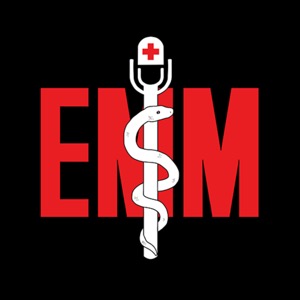Episode 926: Supraventricular Tachycardia
Emergency Medical Minute - A podcast by Emergency Medical Minute - Mondays

Contributor: Taylor Lynch MD Supraventricular tachycardias (SVTs) arise above the bundle of His The term SVT includes AV nodal reentrant tachycardia (AVNRT), atrioventricular reentrant tachycardia (AVRT), atrial tachycardia, atrial fibrillation, atrial flutter, and multifocal atrial tachycardia AVNRT is the most common form of SVT Paroxysmal Spontaneous or provoked by exertion, coffee, alcohol, or thyroid disease More common in women (3:1 women:men ratio) HR 160-240 Narrow complex with a normal QRS Unstable patients receive synchronized cardioversion at 0.5-1 J/kg Valsalva maneuver is attempted before pharmaceutical interventions Increases vagal tone at the AV node to slow conduction and prolongs its refractory period to normalize the conduction Traditionally, patients are asked to bear down, but this only works in 17% of patients REVERT trial assessed a modified valsalva that worked in 43% of patients Adenosine Slows conduction at the AV node by activating potassium channels and inhibiting calcium influx Extremely uncomfortable for most patients Not commonly used anymore Nondihydropyridine calcium-channel blockers are preferred A 2009 RCT investigated low-infusion CCBs compared with adenosine bolus The study found a conversion rate of 98% in the CCB group vs. adenosine group at 86.5% The main adverse effect of CCB is hypotension, which a slow infusion rate can mitigate Diltiazem dose is 0.25 mg/kg/2min and repeat at 0.35 mg/kg/15 minutes or slow infusion at 2.5 mg/min up to a conversion or 50 mg total References 1. Appelboam A, Reuben A, Mann C, et al. Postural modification to the standard Valsalva manoeuvre for emergency treatment of supraventricular tachycardias (REVERT): A randomised controlled trial. Lancet. 2015;386(10005):1747-1753. doi:10.1016/S0140-6736(15)61485-4 Belz MK, Stambler BS, Wood MA, Pherson C, Ellenbogen KA. Effects of enhanced parasympathetic tone on atrioventricular nodal conduction during atrioventricular nodal reentrant tachycardia. Am J Cardiol. 1997;80(7):878-882. doi:10.1016/s0002-9149(97)00539-0 Lim SH, Anantharaman V, Teo WS, Chan YH. Slow infusion of calcium channel blockers compared with intravenous adenosine in the emergency treatment of supraventricular tachycardia. Resuscitation. 2009;80(5):523-528. doi:10.1016/j.resuscitation.2009.01.017 Page RL, Joglar JA, Caldwell MA, et al. 2015 ACC/AHA/HRS Guideline for the Management of Adult Patients With Supraventricular Tachycardia: A Report of the American College of Cardiology/American Heart Association Task Force on Clinical Practice Guidelines and the Heart Rhythm Society [published correction appears in Circulation. 2016 Sep 13;134(11):e234-5. doi: 10.1161/CIR.0000000000000448]. Circulation. 2016;133(14):e506-e574. doi:10.1161/CIR.0000000000000311 Summarized & Edited by Jorge Chalit, OMS3 Donate: https://emergencymedicalminute.org/donate/
